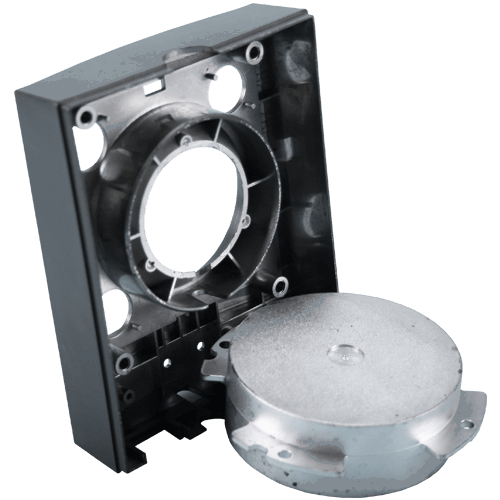For higher EMI/RFI-shielding demands and application we can sputter a full metal, electrically conductive coating onto 90% of all commonly used plastics, including PTFE. The metallization is applied in the form of sandwiching three thin layers of metal.
Sputtering is a technique used to create a thin layer of metal on a part made out of synthetic material. This technique is used for protective coatings that meet extremely high standards.
The process takes place in a high-vacuum chamber, in which argon is brought to a pressure of about 5E-3 mbar. On one wall is sputtered material, this is the so-called target. On the opposite side is the substrate. This is the material the sputtered material is to be made. A voltage of around 500 V is applied on the target. With these pressures in an argon plasma of such positive ions, these ions move visibility into the negatively charged target, the collision with the target material are released and move to the other side fails. After a certain time has a thin layer. Sputtering is faster when the target is behind a magnet. The magnetic field creates an electronic track with a round (or oval) form in the target erosion pattern. Not even metals can be sputtered instead of a DC voltage is an RF voltage is used (usually 13.65 MHz). Sometimes it can / should be a gas (along with argon) to create the desired layer. This is called reactive sputtering.
By this metal ion bombardment melting the metal particle as it were, into the plastic without being affected. And a high degree of adhesion is the result.
First a thin layer of stainless steel, to prevent the softeners in the plastic affecting the shielding. Secondly a thin layer of copper for superb shielding performance. And thirdly another layer of stainless steel to avoid corrosion.
It is also possible to only metallize a part of your plastic housing which is called selective metallization.

Conductive metallization applications
3838 – Conductive metallization shielding performance table
| Frequency (MHz) | Attenuation (dB) |
|---|---|
| 30 | 50 |
| 100 | 58 |
| 200 | 70 |
| 500 | 74 |
| 700 | 72 |
| 900 | 70 |
| These values are measured under laboratory conditions and differ in other practical application. Please read our Guarantee. | |
3838 – Conductive metallisation

| ■3838 – Conductive metallization |
Please note: These values are measured under laboratory conditions. Results may vary in other situations; Please read our Guarantee.
Notice: There are no free samples available for this product